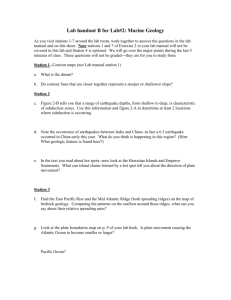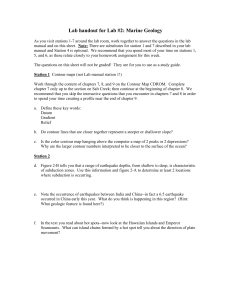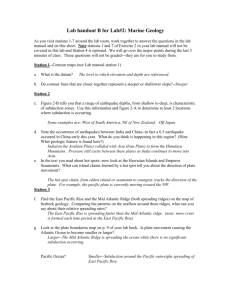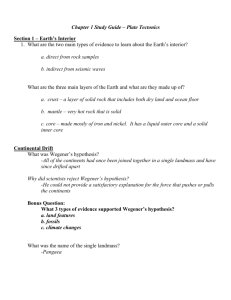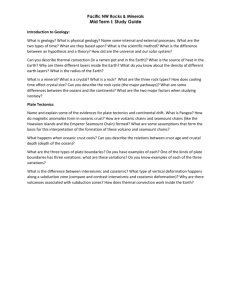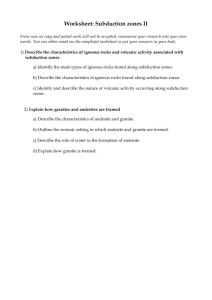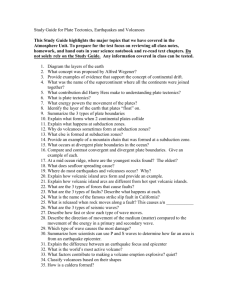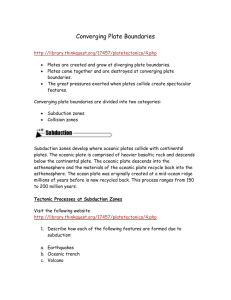labguidekey - Econscience.org
advertisement
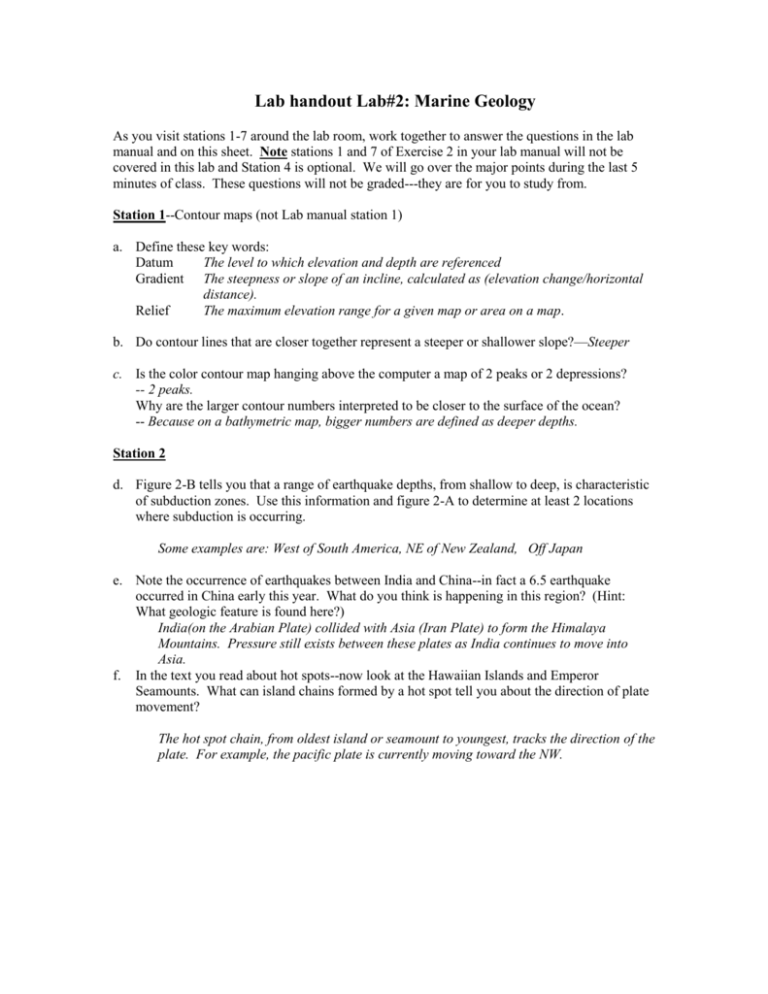
Lab handout Lab#2: Marine Geology As you visit stations 1-7 around the lab room, work together to answer the questions in the lab manual and on this sheet. Note stations 1 and 7 of Exercise 2 in your lab manual will not be covered in this lab and Station 4 is optional. We will go over the major points during the last 5 minutes of class. These questions will not be graded---they are for you to study from. Station 1--Contour maps (not Lab manual station 1) a. Define these key words: Datum The level to which elevation and depth are referenced Gradient The steepness or slope of an incline, calculated as (elevation change/horizontal distance). Relief The maximum elevation range for a given map or area on a map. b. Do contour lines that are closer together represent a steeper or shallower slope?—Steeper c. Is the color contour map hanging above the computer a map of 2 peaks or 2 depressions? -- 2 peaks. Why are the larger contour numbers interpreted to be closer to the surface of the ocean? -- Because on a bathymetric map, bigger numbers are defined as deeper depths. Station 2 d. Figure 2-B tells you that a range of earthquake depths, from shallow to deep, is characteristic of subduction zones. Use this information and figure 2-A to determine at least 2 locations where subduction is occurring. Some examples are: West of South America, NE of New Zealand, Off Japan e. Note the occurrence of earthquakes between India and China--in fact a 6.5 earthquake occurred in China early this year. What do you think is happening in this region? (Hint: What geologic feature is found here?) India(on the Arabian Plate) collided with Asia (Iran Plate) to form the Himalaya Mountains. Pressure still exists between these plates as India continues to move into Asia. f. In the text you read about hot spots--now look at the Hawaiian Islands and Emperor Seamounts. What can island chains formed by a hot spot tell you about the direction of plate movement? The hot spot chain, from oldest island or seamount to youngest, tracks the direction of the plate. For example, the pacific plate is currently moving toward the NW. Station 3 g. Find the East Pacific Rise and the Mid Atlantic Ridge (both spreading ridges) on the map of bedrock geology. Comparing the patterns on the seafloor around these ridges, what can you say about their relative spreading rates? The East Pacific Rise is spreading faster than the Mid-Atlantic ridge. (note: more crust is formed each time period at the East Pacific Rise) h. Look at the plate boundaries map on p. 9 of your lab book. Is plate movement causing the Atlantic Ocean to become smaller or larger? Larger--The Mid Atlantic Ridge is spreading the ocean while there is no significant subduction occurring. Pacific Ocean? Smaller--Subduction around the Pacific outweighs spreading of East Pacific Rise. Station 5 i. Why does oceanic crust tend to "sink" as it moves away from the spreading centers? As the crust cools it becomes heavier. It also accumulates sediment, which makes the crust heavier. j. Would you expect to find a thicker accumulation of sediment at spreading centers or subduction zones? Why? Subduction Zones. Spreading centers are the formation areas for new crust, which have not had time to accumulate sediments--like older crust at subduction zones. k. Does crystal grain size increase or decrease as you go deeper into the lithosphere at a spreading ridge? Why? Increase. The more slowly rock cools, the larger the crystal grain sizes are. Rocks deeper in the earth will cool more slowly. Station 6 l. Why do most metamorphic rocks form at subduction zones, but not at spreading centers? Metamorphic rocks are formed by heat & pressure, transformed from sedimentary rocks or igneous rocks. The heat and pressure needed are more present at subduction zones. m. Why do explosive volcanoes occur near subduction zones? Volcanic eruptions of recycled oceanic crust and sediments are explosive and produce ash, gas, and steam. n. What role does the relative density play at subduction zones? The denser plate (oceanic crust) will sink below less dense plate( continental crust) Station 7--Geology off the Washington Coast. (not station 7 from the lab manual) o. Subduction is occurring of the coast----Speculate as to why there is no trench visible. It is filled with sediment.
